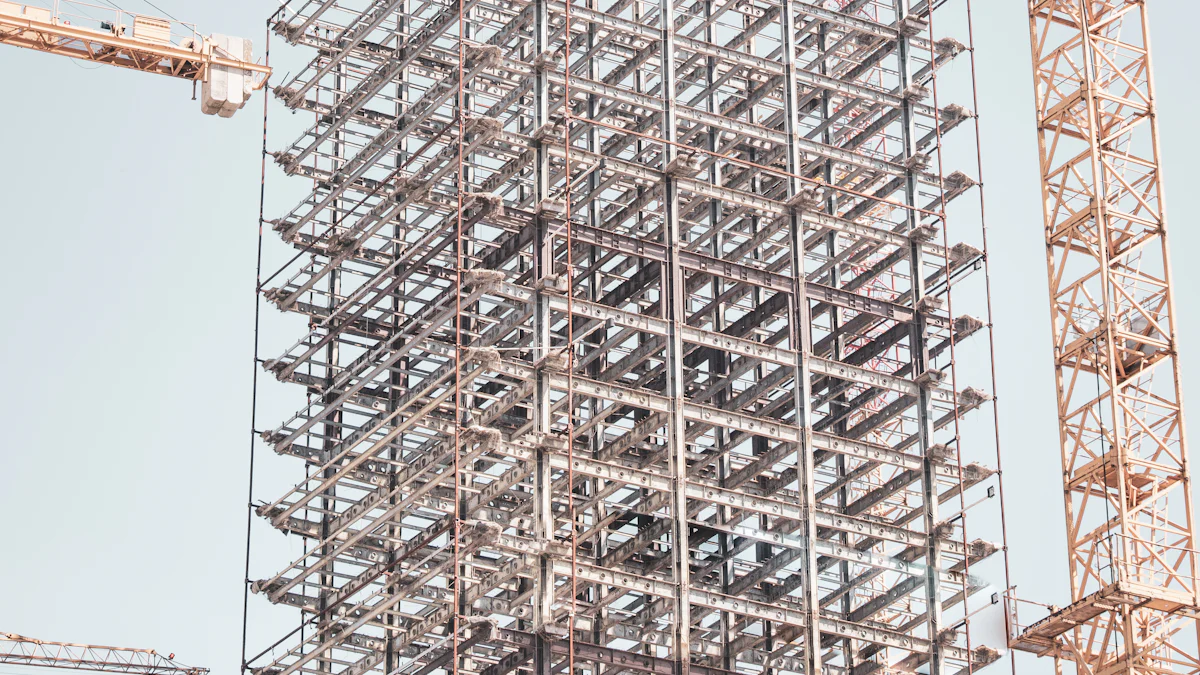Understanding the Structural Design of Overhead Cranes: A Comprehensive Guide
Date: 2024-05-16 Share:
Exploring the Basics of Overhead Cranes
Introduction to Overhead Cranes
Overhead cranes, also known as bridge cranes, are essential components in heavy-duty material handling and manufacturing processes. These cranes are used for lifting and moving heavy loads, ranging from raw materials to finished goods, in a safe and efficient manner. With their ability to move loads horizontally and vertically, overhead cranes have become indispensable in modern factories, warehouses, and construction sites.
Definition and Purpose
The primary function of an overhead crane is to lift and transport heavy objects within a specific area. This is achieved through a hoist, which is mounted on a trolley that moves horizontally along the bridge beam. The versatility of overhead cranes allows them to be utilized in various industries for tasks such as assembly lines, storage yards, and maintenance operations.
Types of Overhead Cranes
There are several types of overhead cranes designed to meet different operational requirements. Some common variations include single girder cranes, double girder cranes, gantry cranes, and jib cranes. Each type has its own unique features and benefits that make it suitable for specific applications.
The Importance of Structural Design
The structural design of overhead cranes plays a crucial role in ensuring safety, efficiency, and customization for diverse applications.
Safety and Efficiency
Data on overhead crane accidents highlights the significance of structural design for safety. Enhanced safety features such as emergency stop buttons, load limit switches, automatic shut-off systems, and LED crane safety lights minimize the risk of accidents and injuries. Furthermore, advancements in control technology have revolutionized safety standards by enabling remote operation from the shop or factory floor.
Customization for Different Applications
Engineers and innovators have significantly improved overhead crane technology over multiple decades. As industrial requirements expanded, the development of overhead bridge cranes kept pace with significant advancements over time. These enhancements include increased productivity through automation integration and smart load monitoring while optimizing performance with lightweight materials and energy-efficient solutions.
What is the structure of an overhead crane?
Overhead cranes are a marvel of engineering, comprising various structural components meticulously designed to ensure optimal functionality and safety. The structural design of an overhead crane encompasses several key elements that work in harmony to facilitate the lifting and movement of heavy loads.
Overview of the Structural Design
Main Structural Components
The main structural components of an overhead crane include the bridge, trolley, hoist, runway system, and control mechanisms. Each component plays a vital role in the crane’s overall operation and performance. The bridge, typically composed of sturdy steel beams, spans the width of the bay or facility and provides support for the trolley mechanism. The trolley travels horizontally along the bridge, carrying the hoist and load.
Material Considerations
When it comes to material considerations for overhead cranes, steel stands out as a primary choice due to its exceptional strength-to-weight ratio and durability. Steel components ensure that the crane can withstand heavy loads while maintaining structural integrity over extended periods of use. Additionally, advancements in lightweight yet robust materials have led to more efficient and agile crane designs.
Detailed Look at the Bridge and Trolley System
Bridge Girders and Their Role
The bridge girders are among the most critical elements of an overhead crane’s structural design. These girders form the primary horizontal beam that supports the trolley as it moves along the length of the bridge. Typically constructed from high-strength steel, these girders provide stability and rigidity essential for safe load transportation.
Trolley Mechanism and Movement
The trolley system is responsible for horizontal movement across the bridge, allowing precise positioning of heavy loads within a defined area. Equipped with wheels or rollers, the trolley smoothly traverses along the bridge girders, guided by a sophisticated track system. This seamless movement ensures efficient material handling operations while minimizing downtime.
Innovations in materials and design have revolutionized overhead crane technology over time, leading to safer, more efficient operations across various industries.
Key Components of Overhead Cranes
Overhead cranes are equipped with essential components that work in synergy to facilitate efficient and safe material handling operations. Among these components, the hoist and control systems play pivotal roles in ensuring precise lifting and seamless operation.
The Role of the Hoist in Lifting
The hoist serves as the primary mechanism for lifting and lowering heavy loads within a defined area. It is mounted on the trolley and is responsible for vertical movement, making it a critical component of overhead crane functionality.
Types of Hoists
There are various types of hoists designed to meet specific lifting requirements. These include electric chain hoists, wire rope hoists, and manual hoists. Electric chain hoists are commonly used for lighter loads due to their versatility and ease of operation, while wire rope hoists are preferred for heavier loads due to their robust construction and durability. Manual hoists, on the other hand, provide a cost-effective solution for simple lifting tasks.
Hoist Operation and Safety Features
Modern hoists are equipped with advanced safety features to ensure secure lifting operations. These features include load limit switches that prevent overloading, emergency braking systems for immediate halting in case of an issue, and anti-collision devices to avoid accidents during material handling processes.
Control Systems and Operator Interface
Control systems are integral to the efficient operation of overhead cranes, providing operators with the ability to manage the crane from various locations while prioritizing safety and precision.
Cab vs. Remote Control Operations
Overhead cranes can be operated from a designated cab within the facility or remotely using advanced remote control systems. Cab operations offer direct visibility of the load and its surroundings, allowing operators to make real-time adjustments based on visual cues. On the other hand, remote control operations provide flexibility by enabling operators to manage crane movements from a safe distance while maintaining optimal visibility through cameras and sensors.
Safety and Control Features
Control systems incorporate a range of safety features such as variable speed options, emergency stop functions, overload protection mechanisms, and real-time diagnostics for proactive maintenance. These features ensure that crane operations adhere to strict safety standards while maximizing efficiency in material handling processes.
Design Considerations for Overhead Cranes
When it comes to the design considerations for overhead cranes, two key factors significantly impact their performance and suitability for specific applications: load capacity and span, and environmental and operational considerations.
Load Capacity and Span
Determining Load Requirements
The load capacity of an overhead crane is a critical aspect that directly influences its ability to handle various weights. Understanding the specific load requirements within a facility is essential for selecting the appropriate crane model. Overhead cranes offer greater efficiency and increased load capacity compared to traditional material handling methods such as forklifts. This allows for seamless movement of heavy loads, reducing damage rates and enhancing overall cost savings.
Moreover, overhead cranes are modular and adaptable, providing customization options to meet diverse load requirements. The integration of smart load monitoring systems ensures precise handling of loads while optimizing energy efficiency. These features make overhead cranes a preferred choice for industries seeking intelligent material handling solutions.
Span and Its Impact on Design
The span of an overhead crane refers to the distance between the runways or rails on which the crane operates. The span directly impacts the coverage area and lifting capabilities of the crane. Indoor cranes are designed with varying spans to accommodate different facility layouts, allowing them to lift tons of weight to a variety of places with ease.
Additionally, advancements in lightweight materials have led to more compact designs without compromising load-bearing capacity. This enables overhead cranes to be easily integrated into existing workflows and infrastructure, further enhancing their adaptability in diverse industrial settings.
Environmental and Operational Considerations
Indoor vs. Outdoor Use
Overhead cranes are engineered to operate efficiently in both indoor and outdoor environments, offering versatility across various applications. Their ability to withstand harsh environmental conditions makes them suitable for outdoor use, where they can effectively handle heavy loads in open yards or construction sites.
In contrast, indoor cranes are designed with special features tailored for confined spaces within manufacturing facilities or warehouses. These cranes provide intelligent material handling solutions while ensuring optimal safety standards in indoor settings.
Special Features for Harsh Environments
Overhead cranes excel in harsh environments due to their robust structural design and advanced features tailored for challenging operational conditions. They offer increased safety measures compared to other material handling methods by incorporating anti-collision devices, emergency braking systems, and real-time diagnostics for proactive maintenance.
Furthermore, the integration of energy-efficient components aligns with sustainability initiatives by minimizing power consumption without compromising performance. Lightweight materials contribute to improved ergonomics while maintaining high load capacities, making overhead cranes an ideal choice for environmentally conscious industries seeking efficient material handling solutions.
Conclusion
Recap of Key Points
In summary, understanding the structural design of overhead cranes is essential for comprehending their pivotal role in material handling and manufacturing operations. The intricate combination of bridge girders, trolley mechanisms, hoists, and control systems ensures efficient and safe lifting of heavy loads within diverse industrial settings. The structural design not only prioritizes safety and customization but also contributes to the overall productivity and operational excellence of overhead cranes.
The future of overhead crane technology is marked by a relentless pursuit of innovation, efficiency, and sustainability. Manufacturers have responded to industry demands by emphasizing energy-efficient solutions through cutting-edge technology such as variable frequency drives, regenerative braking systems, and sophisticated power management systems. These advancements not only enhance operational efficiency but also align with sustainability initiatives by minimizing power consumption without compromising performance.
Furthermore, the adoption of AI, VR, machine learning, and AR in the overhead crane industry holds immense potential for improving performance, accuracy, and safety even further. These cutting-edge innovations are poised to revolutionize the landscape of overhead crane technology by introducing advanced capabilities for remote monitoring, predictive maintenance, and enhanced operator interfaces.
The Future of Overhead Crane Design
Technological Advancements
The evolution of overhead bridge cranes has been driven by continuous innovation aimed at pushing the boundaries of efficiency and safety. Smart load monitoring systems, regenerative braking systems, efficient motor designs, IoT connectivity for remote monitoring and maintenance are just a few examples of how technological advancements are shaping the future landscape of overhead crane design.
Sustainability in Crane Design
The emphasis on sustainability in crane design is evident through the integration of energy-efficient components that minimize power consumption while maintaining high performance standards. This commitment to sustainability aligns with global initiatives for environmental responsibility while offering long-term cost savings for industries utilizing overhead cranes.
As industries continue to evolve and embrace technological advancements in material handling equipment, the future holds promising prospects for further enhancing the capabilities and sustainability of overhead crane design. With a focus on innovation-driven solutions and sustainable practices, the next generation of overhead cranes is poised to redefine efficiency and safety standards across various industrial sectors.
Nante Crane
Nante Crane, a renowned manufacturer of overhead cranes, offers a unique and robust structural design that ensures safety, efficiency, and durability. The structural design of Nante Crane’s overhead cranes is a testament to their commitment to quality and innovation.
The primary structure of Nante Crane’s overhead cranes is the bridge, which is a horizontal beam that carries the load. The bridge is usually made up of two end trucks and one or two bridge girders, depending on the crane’s capacity. The bridge girders are designed to withstand the load and the stress caused by the crane’s movement.
The hoist and trolley, which lift and move the load along the bridge, are another critical part of the crane’s structure. Nante Crane offers a variety of hoists and trolleys, each designed for specific applications and load capacities. The hoist is equipped with a wire rope or chain, and a hook for attaching the load. The trolley is designed to move smoothly along the bridge, carrying the hoist and the load.
The runway, which supports the crane, is another essential part of the crane’s structure. It consists of two parallel rails, supported by a structure of beams and columns. The runway is designed to support the weight of the crane and the load, and to provide a stable and secure path for the crane’s movement.
The drive mechanisms, which move the crane and trolley, are also a crucial part of the crane’s structure. Nante Crane’s drive mechanisms are designed for smooth and precise movement, ensuring efficient operation of the crane.
In conclusion, the structural design of Nante Crane‘s overhead cranes is a perfect blend of strength, efficiency, and safety. Understanding this design is crucial for anyone involved in the operation, maintenance, or inspection of overhead cranes.
 English
English







